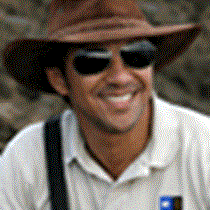Southern Isabela Island
The island of Isabela is at least half of the land mass territory in the Galápagos Islands; therefore it needs a bit more of attention during our exploration, especially its southern side. We are really glad that we took our chance to explore this area, since many highlights of the week have been encountered at the two sites that we’d chosen to explore today.
Bahia Urbina happens to be one of those locations that hold an interesting geological background; more than three miles of land were uplifted as much as twelve feet above the sea level back in 1954. This geological event was witnessed by a couple of ships that were navigating along the area, so it was well documented and reported. Big pieces of coral, as well as many other living organisms, rose with the lava flows, making this a unique event! Most of our morning was dedicated to exploring this region, and besides the wonderful view of the uplifted coastline, we found ourselves immersed in the middle of “mini ecosystems” that have been formed after the 1954 events.
Land iguanas were a big deal this morning since we hiked right in the middle of their territory. The big surprise was definitely the sight of at least five giant tortoises wondering the low grounds of the island. This area was severely attacked by introduced animals such as goats and donkeys; they are now under the process of being eradicated, and that is precisely why the ecosystem has been restored and the giant tortoises are coming back to their natural migration routes.
The afternoon was dedicated to explore the shorelines of Punta Moreno; a nearby ecosystem full of mangroves along the coastline, but once in land, the landscape turned into barren, lifeless lava flows. Once walking in the island we realized that this area was anything but lifeless, since sunken lava had created shelters for plants and birds to take over. Flamingoes and ducks were found swimming in the brackish water lagoons that were hidden behind the dense vegetation.
By the end of the day we were all feeling as if we just visited another planet! Ecosystems that we never thought could be possibly found in areas like this were found, and the restoration of damaged ones had made possible endemic populations of animals to make a successful comeback. It was definitely a great day!
The island of Isabela is at least half of the land mass territory in the Galápagos Islands; therefore it needs a bit more of attention during our exploration, especially its southern side. We are really glad that we took our chance to explore this area, since many highlights of the week have been encountered at the two sites that we’d chosen to explore today.
Bahia Urbina happens to be one of those locations that hold an interesting geological background; more than three miles of land were uplifted as much as twelve feet above the sea level back in 1954. This geological event was witnessed by a couple of ships that were navigating along the area, so it was well documented and reported. Big pieces of coral, as well as many other living organisms, rose with the lava flows, making this a unique event! Most of our morning was dedicated to exploring this region, and besides the wonderful view of the uplifted coastline, we found ourselves immersed in the middle of “mini ecosystems” that have been formed after the 1954 events.
Land iguanas were a big deal this morning since we hiked right in the middle of their territory. The big surprise was definitely the sight of at least five giant tortoises wondering the low grounds of the island. This area was severely attacked by introduced animals such as goats and donkeys; they are now under the process of being eradicated, and that is precisely why the ecosystem has been restored and the giant tortoises are coming back to their natural migration routes.
The afternoon was dedicated to explore the shorelines of Punta Moreno; a nearby ecosystem full of mangroves along the coastline, but once in land, the landscape turned into barren, lifeless lava flows. Once walking in the island we realized that this area was anything but lifeless, since sunken lava had created shelters for plants and birds to take over. Flamingoes and ducks were found swimming in the brackish water lagoons that were hidden behind the dense vegetation.
By the end of the day we were all feeling as if we just visited another planet! Ecosystems that we never thought could be possibly found in areas like this were found, and the restoration of damaged ones had made possible endemic populations of animals to make a successful comeback. It was definitely a great day!



